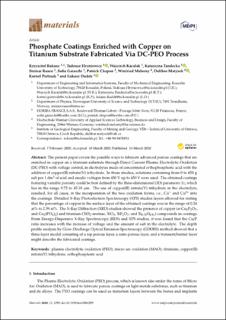| dc.contributor.author | Rokosz, Krzysztof | |
| dc.contributor.author | Hryniewicz, Tadeusz | |
| dc.contributor.author | Kacalak, Wojciech | |
| dc.contributor.author | Tandecka, Katarzyna | |
| dc.contributor.author | Raaen, Steinar | |
| dc.contributor.author | Gaiaschi, Sofia | |
| dc.contributor.author | Chapon, Patrick | |
| dc.contributor.author | Malorny, Winfried | |
| dc.contributor.author | Matysek, Dalibor | |
| dc.contributor.author | Pietrzak, Kornel | |
| dc.contributor.author | Dudek, Lukasz | |
| dc.date.accessioned | 2020-05-28T06:57:57Z | |
| dc.date.available | 2020-05-28T06:57:57Z | |
| dc.date.created | 2020-05-25T13:42:21Z | |
| dc.date.issued | 2020 | |
| dc.identifier.citation | Materials. 2020, 13 (6), . | en_US |
| dc.identifier.issn | 1996-1944 | |
| dc.identifier.uri | https://hdl.handle.net/11250/2655849 | |
| dc.description.abstract | The present paper covers the possible ways to fabricate advanced porous coatings that are enriched in copper on a titanium substrate through Direct Current Plasma Electrolytic Oxidation (DC-PEO) with voltage control, in electrolytes made of concentrated orthophosphoric acid with the addition of copper(II) nitrate(V) trihydrate. In these studies, solutions containing from 0 to 650 g salt per 1 dm3 of acid and anodic voltages from 450 V up to 650 V were used. The obtained coatings featuring variable porosity could be best defined by the three-dimensional (3D) parameter Sz, which lies in the range 9.72 to 45.18 μm. The use of copper(II) nitrate(V) trihydrate in the electrolyte, resulted, for all cases, in the incorporation of the two oxidation forms, i.e., Cu+ and Cu2+ into the coatings. Detailed X-Ray Photoelectron Spectroscopy (XPS) studies layers allowed for stating that the percentage of copper in the surface layer of the obtained coatings was in the range of 0.24 at% to 2.59 at%. The X-Ray Diffraction (XRD) studies showed the presence of copper (α-Cu2P2O7, and Cu3(PO4)2) and titanium (TiO2-anatase, TiO3, TiP2O7, and Ti0.73O0.91) compounds in coatings. From Energy-Dispersive X-Ray Spectroscopy (EDS) and XPS studies, it was found that the Cu/P ratio increases with the increase of voltage and the amount of salt in the electrolyte. The depth profile analysis by Glow-Discharge Optical Emission Spectroscopy (GDOES) method showed that a three-layer model consisting of a top porous layer, a semi-porous layer, and a transient/barrier layer might describe the fabricated coatings. | en_US |
| dc.language.iso | eng | en_US |
| dc.publisher | MDPI | en_US |
| dc.rights | Navngivelse 4.0 Internasjonal | * |
| dc.rights.uri | http://creativecommons.org/licenses/by/4.0/deed.no | * |
| dc.title | Phosphate Coatings Enriched with Copper on Titanium Substrate Fabricated Via DC-PEO Process | en_US |
| dc.type | Peer reviewed | en_US |
| dc.type | Journal article | en_US |
| dc.description.version | publishedVersion | en_US |
| dc.source.pagenumber | 19 | en_US |
| dc.source.volume | 13 | en_US |
| dc.source.journal | Materials | en_US |
| dc.source.issue | 6 | en_US |
| dc.identifier.doi | 10.3390/ma13061295 | |
| dc.identifier.cristin | 1812454 | |
| dc.description.localcode | ©2020 by the authors. Licensee MDPI, Basel, Switzerland. This article is an open accessarticle distributed under the terms and conditions of the Creative Commons Attribution(CC BY) license (http://creativecommons.org/licenses/by/4.0/). | en_US |
| cristin.ispublished | true | |
| cristin.fulltext | original | |
| cristin.qualitycode | 1 | |

